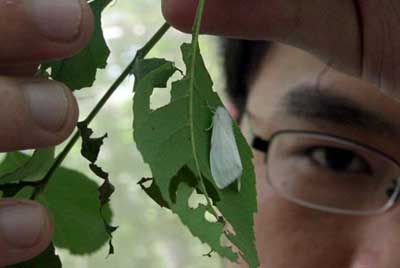| Home / Environment / Photo News | Tools: Save | Print | E-mail | Most Read |
| Invasive Alien Species in the Cross Hairs |
| Adjust font size: |
Beijing will launch a campaign against assaults by alien insect species on the city's trees to guarantee plenty of greenery for the 2008 Olympic Games, said a senior forestry administrator yesterday. Wei Diansheng, director of the Forestation Department at the State Forestry Administration (SFA), said Hyphantria cunea, or the American White Moth, a species native to North America, could pose a threat to Beijing's vision of holding a "Green Olympics".
A family of American White Moth larvae can eat all the leaves off a healthy tree in just a few days. The species was first spotted in Beijing and surrounding areas, including Tianjin Municipality and Hebei Province, in 2005. An investigation by the SFA showed that in 2005, 156,000 hectares of trees were stricken by the moths. The moths had spread to an additional 67,000 hectares in the following year. The destructive moths are expected to devour another 47,000 hectares of trees in Beijing and its adjacent regions this year, Wei said. "Given the grave situation, we must stick to our prevention goal to ensure Beijing's ecological security as well as the success of the Green Olympics," he said. The SFA has no statistics on the economic losses caused by the American White Moth, though it has placed the prevention and control of insect pests at the top of its working agenda, giving the issue the same importance as preventing fires. "Because of the timely measures the capital took to combat the moth, a serious outbreak in Beijing is not a foregone conclusion," the SFA said "But the area round Beijing should keep on high alert." Beijing and Hebei planned to prepare planes to spray insecticide on 115,000 hectares of trees that are at risk of destruction or have already been attacked by the moths. Other measures, like making light traps and cultivating the moth's natural enemies, are under preparation. Beijing, Tianjin and three other nearby provinces have pooled about 66 million yuan (US$8.3 million) to help pay for the effort. Plant diseases and insect pests are expected to pose more serious threats this year than in the past, the SFA has said. More than 11 million hectares of trees nationwide are expected to be attacked by plant diseases, insect pests, rats, rabbits and invasive plants. In addition to the American White Moths, the species Dendroctonus valens leconte is also at the center of focus of prevention and control efforts by the forestry management department. Such pests, which also originated in North America, are expected to harm 80,000 hectares of trees this year, or 20 percent less than last year. Warm winter weather, a global outbreak of pest disasters and a high ratio of young and vulnerable trees in China's forests have all contributed to the challenge of containing invasive alien species, according to the SFA. The SFA is planning a long-term cooperative effort with the meteorological administration in a bid to predict potential attacks by pests and other harmful species. The effort had a trial run on March 6, during Jingzhe, one of the 24 points on the Chinese lunar calendar, signifying the point when insects hatch. (China Daily April 5, 2007) |
| Tools: Save | Print | E-mail | Most Read |
 |
| Related Stories |
